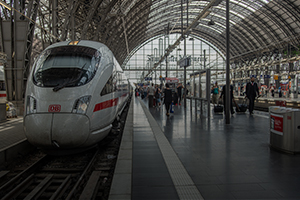Hydrogen-Powered Trains

Just two years after being introduced at the InnoTrans exposition in Berlin, the first two carbon-dioxide-emission-free regional trains have been put into commercial service in northern Germany. Coradia iLint, the world’s first passenger train to be powered by a hydrogen fuel cell, was recently put into service along a 100-kilometer line between Cuxhaven and Buxtehude just west of Hamburg. A dedicated hydrogen fueling station at Bremervörde supplies the tanks, which hold enough fuel to travel about 1,000 kilometers.
In addition to the fuel cell, a small battery helps manage power output to maintain continuity and stores energy captured from the regenerative braking system. The electric engine is virtually noise-free, and the only emissions are steam and condensed water.
While railways have long been in need of a clean-energy solution, the choice of technologies is somewhat limited. Electrification of rail lines is cost-prohibitive on a large scale, and batteries pose a constant trade-off between weight, cost and power output. Although hydrogen is not yet a totally clean fuel (in terms of production), there is a push toward generating it with 100 percent renewables in the future. That fact, combined with its high energy density, make hydrogen the fuel of choice for sustainable heavy rail transport.
The manufacturer of Coradia iLint plans to deliver an additional fourteen trains by 2021.
For information: Alstom, Joachimsthaler Strasse 12/Ecke, Kurfürstendamm, Berlin, 10179; phone: +49-(0)30-330-96380; Web site: https://www.alstom.com/